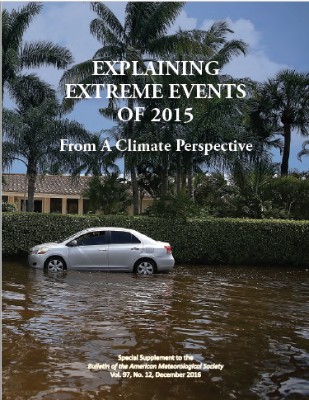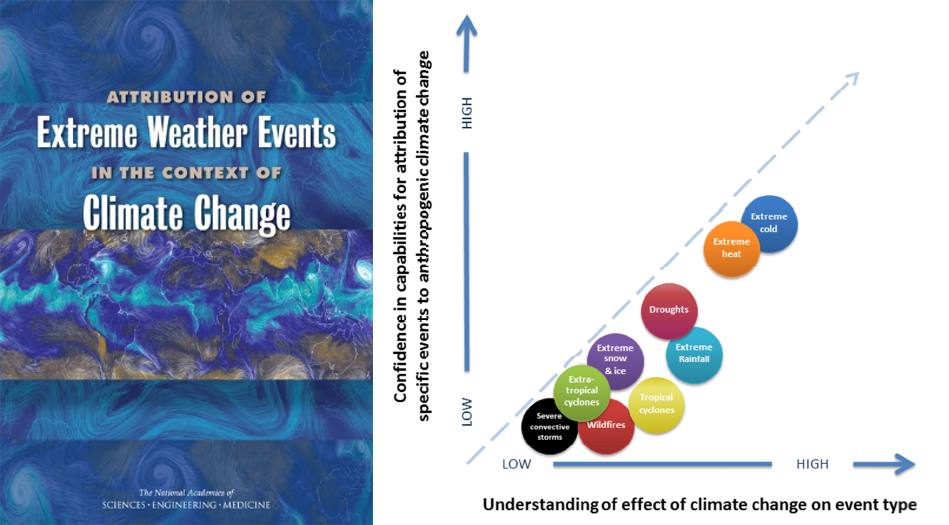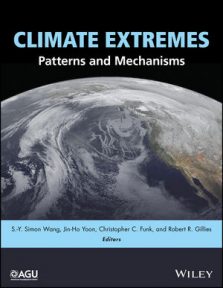In This Section
Getting to know attribution studies: basic concepts and references

Attribution is considered the process of evaluating the relative contribution of multiple causal factors to a change or event with an assignment of statistical confidence (Hergerl et al., 2010).
You can learn some basic concepts about attribution and on how it works with this short but very instructive video produced by Professor Myles Allen (Oxford Martin School).
In 2012 the Bulletin of the American Meteorological Society (BAMS) published its first annual report on climate change attribution of extreme weather events. The authors submitted their works on attribution studies of extreme events which occurred across the world during the previous year. Although some skew can be perceived in relation to the areas studied or the interests of scientists, the number of papers has been increasing since then, as well as the interest due to applications of the findings in areas such as the management of land use or the development of improved forecast systems.

The book ATTRIBUTION OF EXTREME WEATHER EVENTS IN THE CONTEXT OF CLIMATE CHANGE, published in 2016 by the National Academies of Sciences, Engineering and Medicine, integrates all the basic concepts and approaches used in this relatively new field of research, Probabilistic Event Attribution (PEA)*. It offers guidance on how to carry out an end-to-end attribution study. For example, it addresses the importance of correctly framing the attribution question in order to clarify whether the frequency and/or magnitude of the event that we are going to study is experiencing changes due to a specific driver and to what extent. It also provides full information of the different methods that can be applied, as well as an overview for various event types, along with some results, such as extreme heat, extreme cold, droughts and extreme rainfall. These events, as they highlight, are also those which offer the highest confidence in attribution studies (as you can see in the figure on the right, below, reproduced from the book), but also the events which attract the most media and public attention.

It is therefore, a good point to start to go into greater depth on attribution studies and how is possible to probabilistically determine the contribution of a driver, such as the human greenhouse gases emissions, to an extreme event.
Today, a new book about the impact of climate change on weather and climate events has been launched by the American Geophysical Union, CLIMATE EXTREMES: PATTERNS AND MECHANISMS. To accompany the launch, the editors offered an interview. They spoke about the importance of attribution studies in the forecasting of weather and climate extremes, the regions of the world most vulnerable to extremes, and the benefits of increasing the resolution of the models, which could help to better understand the events from a physical point of view. However, they share their concerns about the continuing decrease in the number of weather stations and other observational data, which are necessary to validate climate models.

Here you will find the interview: https://eos.org/editors-vox/how-does-changing-climate-bring-more-extreme-events
We hope you enjoy these (maybe summer) readings.
* Also called Attribution of Climate-Related Events (ACE).
REFERENCES
- Hegerl, G.C., Hoegh-Guldberg, O., Casassa, G., Hoerling, M.P., Kovats, R.S., Parmesan, C., Pierce, D.W. and Stott, P.A., 2010. Good practice guidance paper on detection and attribution related to anthropogenic climate change. In Meeting Report of the Intergovernmental Panel on Climate Change Expert Meeting on Detection and Attribution of Anthropogenic Climate Change. IPCC Working Group I Technical Support Unit, University of Bern, Bern, Switzerland.
- National Academies of Sciences, Engineering, and Medicine, 2016. Attribution of Extreme Weather Events in the Context of Climate Change. Washington, DC: The National Academies Press.
- S.-Y. Simon Wang (Editor), Jin-Ho Yoon (Editor), Christopher C. Funk (Editor), Robert R. Gillies (Editor), 2017. Climate Extremes: Patterns and Mechanisms. American Geophysical Union. ISBN: 978-1-119-06784-9. 400 pages.
ClimATT
Climate Change Attribution of Extreme Weather Events
Contact us
